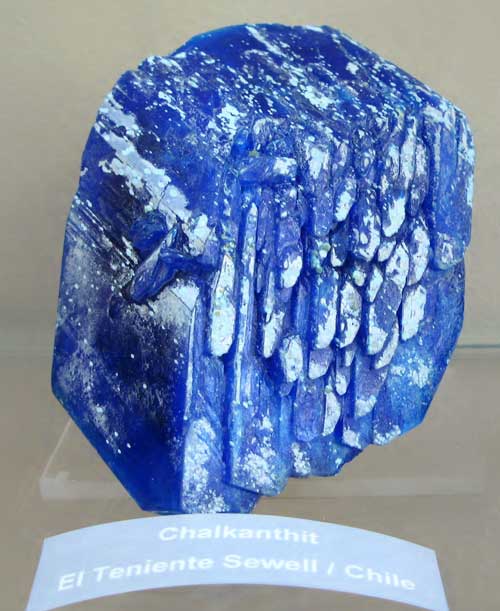| - Art Gallery - |
Chalcanthite - Locality: El Teniente Sewell, Chile (*)
Chalcanthite, whose name derives from the Greek, chalkos and anthos, meaning copper flower, is a richly-colored blue/green water-soluble sulfate mineral, commonly found in the late-stage oxidation zones of copper deposits. Due to its ready solubility, chalcanthite is more frequently found in greater abundance in arid regions. Chalcantite is the most common member of a group of related hydrated sulfates. These other sulfates are identical in chemical composition to chalcanthite, with the exception of replacement of the copper ion by either manganese (forming jokokuite, MnSO4 · 5H2O, iron (forming siderotil, FeSO4 · 5H2O), or magnesium (forming pentahydrite, MgSO4 · 5H2O). As chalcanthite is a copper mineral, it can be used as an ore of copper. However, its ready solubility in water means that it tends to crystallize, dissolve, and recrystallize as crusts over any mine surface in more humid regions. Therefore, chalcanthite is only found in the most arid regions in sufficiently large quantities for use as an ore. Secondarily, chalcanthite, due to its rich color and beautiful crystals, is a sought after collector's mineral. However, as with its viability as an ore, the solubility of the mineral causes significant problems. First, the mineral readily absorbs and releases its water content, which, over time, leads to a disintegration of the crystal structure, destroying even the finest specimens. Second, higher quality crystals can be easily grown synthetically, and, as such, there is a concern that disreputable mineral dealers would present a sample as natural when it is not. Associated minerals Given that chalcanthite is found in oxidized copper deposits, it is frequently found in association with other copper minerals. Frequently associated minerals include
Alternative names Chalcanthite has several alternative names, including blue stone, blue vitriol, and copper vitriol. Notes for identification Chalcanthite's blue color is one of its most notable features, but it is insufficient in identification. Other useful tests include associated minerals, crystal habit, solubility and subsequent coloring of the water blue, and taste. A special note on tasting chalcanthite, however: chalcanthite has a sweetly metallic taste, but taste testing should not be done haphazardly. The specimen should be lightly touched to the tip of the tongue only, as chalcanthite is poisonous. See also * Copper(II) sulfate References
Retrieved from "http://en.wikipedia.org/" |
|
||||||||||||||||||||||||||||||||||||||

